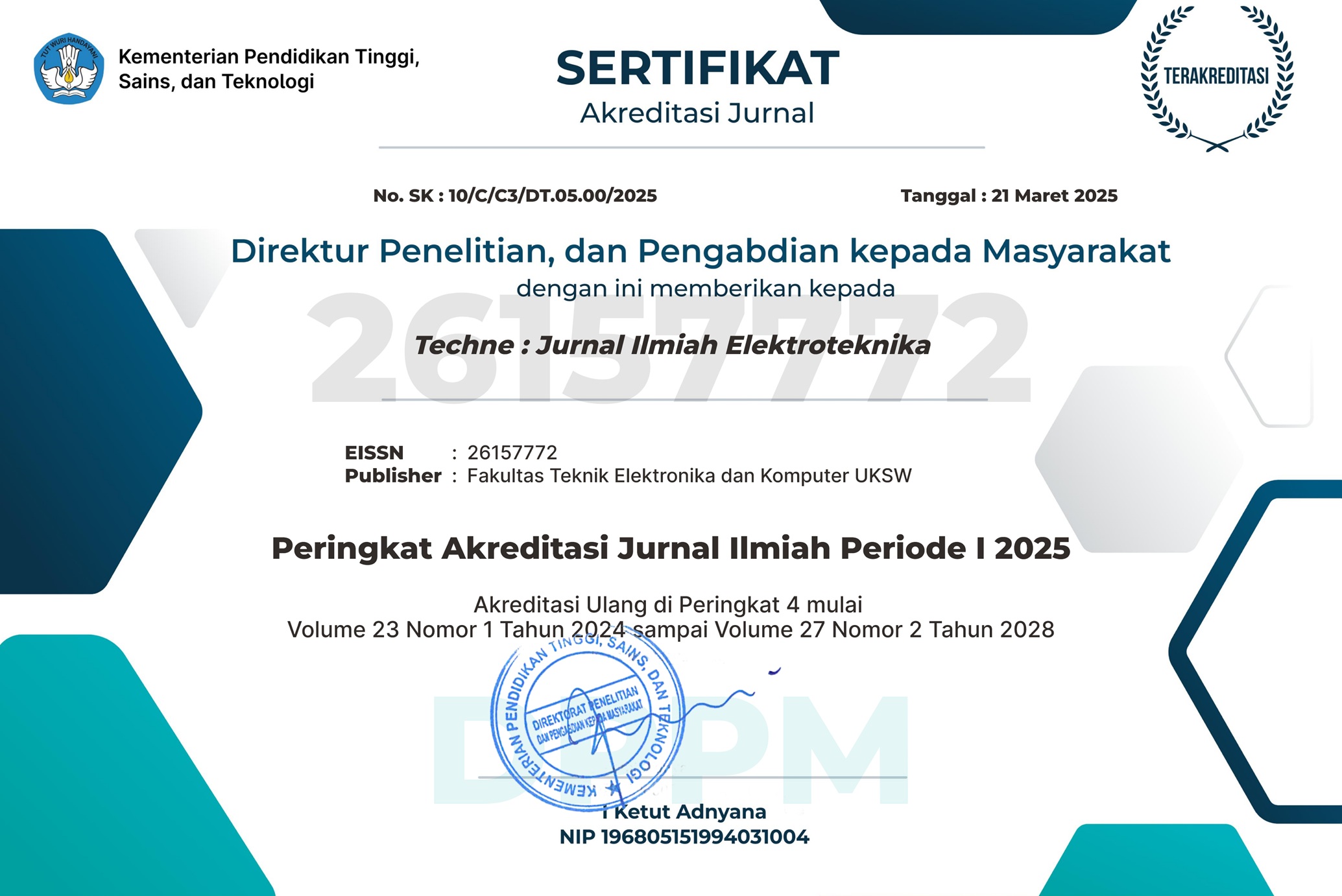Performance Analysis of Bipolar Optical Code Division Multiple Access with Dual Electro-Optical Modulator Scheme for Free-Space Optical Communication
DOI:
https://doi.org/10.31358/techne.v20i2.270Keywords:
performance, SAC codes, bipolar OCDMA, dual EOM, FSOAbstract
In this study, the performance of bipolar optical code division multiple access (OCDMA) with dual electro-optical modulator (EOM) scheme for multi-user scenario was tested and analyzed with OptiSystem version 10. The performance measurement was implemented for free-space optical (FSO) communication and includes the common noises in optical communication. Two different channels were used in the measurement, i.e., additive white Gaussian noise (AWGN) and fading channel. Two extreme weather conditions, strong rain and storm, were considered in the simulation. The performance between three spectral amplitude coding (SAC) codes, i.e., Modified M-Sequence code, Walsh-Hadamard code, and random diagonal (RD) code were measured and compared. The simulation results indicate that Modified M-Sequence code had the highest BER while RD code achieved the lowest BER in the short-range and Walsh-Hadamard code got the lowest BER for the medium-range of FSO, both for AWGN only and AWGN with fading channel. In strong turbulence condition, the performance of all codes become comparable after 500 m of FSO range. Modified M-Sequence suffered the lowest performance degradation while RD code endured the highest performance deterioration in all-weather condition. The results show that Modified M-Sequence can be applied for medium to long-range FSO.
Downloads
References
[2] C.D. Alwis, A. Kalla, Q.-V. Pham, P. Kumar, K. Dev, W.-J. Hwang, M. Liyanage, Madhusanka, “Survey on 6G frontiers: trends, applications, requirements, technologies and future research,” IEEE OJ-COMS, vol. 2, pp. 836-886, 2021. Doi: 10.1109/OJCOMS.2021.3071496.
[3] M.W. Akhtar, S. Hassan, R. Ghaffar, H. Jung, S. Garg, M.S. Hossain, “The shift to 6G communications: vision and requirements,” Hum. -centric comput. inf., vol. 10, 2021. Doi: 10.1186/s13673-020-00258-2.
[4] A. Malik, P. Singh, “Free space optics: current applications and future challenges,” Int. J. Opt., vol. 2015, pp. 1-7, 2015. Doi: 10.1155/2015/945483.
[5] D. Ahlawat, P. Arora, S. Kumar, “Performance evaluation of proposed WDM optical link using EDFA and FBG combination,” J. Opt. Commun., vol. 40, 2018. Doi: 10.1515/joc-2018-0044.
[6] A. Cardenas, V. Valderrama, B. Javier, “Performance of WDM-OFDM for using unequalized optical frequency comb,” IEEE Lat. Am. Trans., vol. 13, pp. 2551-2558, 2015. Doi: 10.1109/TLA.2015.7331911.
[7] A.H. Ali, A. Desher, “Design and performance analysis of the WDM schemes for radio over fiber system with different fiber propagation losses,” Fibers, vol. 7, no. 19, 2019. Doi: 10.3390/fib7030019.
[8] J. Zhang, A.B. Sharma, “High-speed optical time-division multiple-access (OTDMA) networks using optical signal processing,” Photonic Netw. Commun. vol. 1, pp. 273–285, 1999. Doi: 10.1023/A:1010070632272.
[9] Z.J. Ren, K. Cui, J.X. Li, R.H. Zhu, Q. He, H.L. Wang, S.K. Deng, W.J. Peng, “High-quality hybrid TDM/DWDM-based fiber optic sensor array with extremely low crosstalk based on wavelength-cross-combination method,” Opt. Express, vol. 25, no. 28870, 2017. Doi: 10.1364/OE.25.028870.
[10] C.B.M. Rashidi, S.A. Aljunid, F. Ghani, H.A. Fadhil, M.S. Anuar, “Phase induced intensity noise evasion in SAC-OCDMA systems using flexible cross correlation (FCC) code algorithm,” Aust. J. Basic & Appl. Sci, vol. 7, pp. 437-446, 2013.
[11] H.M.R. Al-Khafaji, S.A. Aljunid, H.A. Fadhil, “Spectral efficiency analysis of bipolar spectral amplitude coding optical code-division multiple access systems using different one-dimensional codes,” IET Optoelectron., vol. 6, pp. 215-222, 2012. Doi: 10.1049/iet-opt.2011.0051.
[12] S.J. Park, B.K. Kim, B. Kim, “An OCDMA scheme to reduce multiple access interference and enhance performance for optical subscriber access networks,” ETRI J, vol. 26, no. 1, pp. 13-20, 2004. Doi: 10.4218/etrij.04.0103.0002.
[13] H.C. Cheng, E. Wijanto, T.-C. Lien, P.-H. Lai, S.-P. Tseng, “Multiple access techniques for bipolar optical code division in wireless optical communications,” IEEE Access, vol. 8, pp. 83511-83523, 2020. Doi: 10.1109/ACCESS.2020.2991071.
[14] S.P. Tseng, E. Wijanto, P.H. Lai, H.C. Cheng, “Bipolar optical code division multiple access techniques using a dual electro-optical modulator implemented in free-space optics communications,” Sensors, vol. 20, no. 12, pp. 3583, 2020. Doi: 10.3390/s20123583.
[15] E. Wijanto, C.-M. Huang, “Design of bipolar optical code-division multiple-access techniques using phase modulator for polarization coding in wireless optical communication,” Appl. Sci., vol. 11, pp. 5955, 2021. Doi: 10.3390/app11135955.
[16] C.T. Yen, W. Chen, “A study of bipolar walsh-hadamard coding method in optical CDMA networks,” Appl. Mech. Mater, no. 284-287, pp. 2667-2671, 2013. Doi: 10.4028/www.scientific.net/AMM.284-287.2667.
[17] H. Fadhil, S. Aljunid, R.B. Ahmad, “Performance of random diagonal code for OCDMA systems using new spectral direct detection technique,” Opt. Fiber Technol., vol. 15, pp. 283-289, 2009. Doi: 10.1016/j.yofte.2008.12.005.
[18] H. Al-Khafaji, R. Ngah, S. Aljunid, T. Rahman, “A new two-code keying scheme for SAC-OCDMA systems enabling bipolar encoding,” J Mod Opt, vol. 62, no. 5, pp. 327-335, 2015. Doi: 10.1080/09500340.2014.978914.
[19] C.-T. Yen, H.-C. Cheng, Y.-T. Chang, W.-B. Chen, “Performance analysis of dual unipolar/bipolar spectral code in optical CDMA systems,” J. Appl. Res. Technol., vol. 11, pp. 235-241, 2013. Doi: 10.1016/S1665-6423(13)71533-5.
[20] H. Mrabet, S. Mhatli, I. Dayoub, E. Giacoumidis, “Performance analysis of AO-OFDM-CDMA with advanced 2D-hybrid coding for amplifier-free LR-PONs,” IET Optoelectron., vol. 12, 2018. Doi: 10.1049/iet-opt.2018.5042.
[21] N. Dong-Nhat, M.A. Elsherif, A. Malekmohammadi, “Investigations of high-speed optical transmission systems employing absolute added correlative coding (AACC),” Opt. Fiber Technol., vol. 30, pp. 23–31, 2016.
[22] N. Avlonitis, E. Yeatman, M. Jones, A. Hadjifotiou, “Multilevel amplitude shift keying in dispersion uncompensated optical systems,” IET Optoelectron., vol. 153, pp. 101–108, 2006. Doi: 10.1049/ip-opt:20050039.
[23] International Telecommunication Union. Propagation data required for the design of terrestrial free-space optical links, P Series Radiowave propagation, P.1817-1, 2012.








